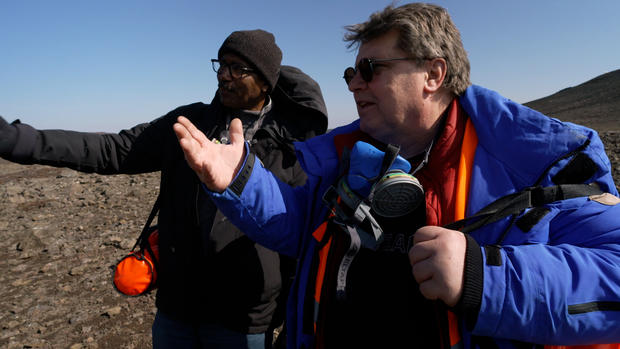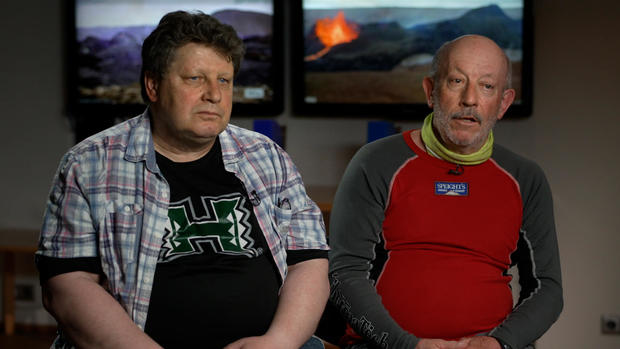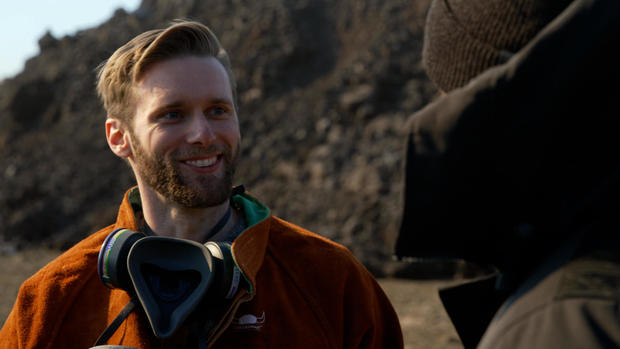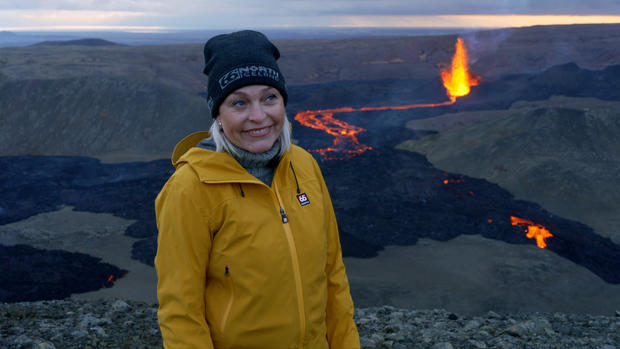Last March, when we first reported in this story, an unprecedented swarm of more than 30,000 earthquakes shook a corner of southwest Iceland and rattled houses in the capital, Reykjavík, 20 miles away. Some tremors lasted only a few seconds. Others punched in at 5.4 on the Richter scale. Icelanders are used to earthquakes – the whole island is a volcanic hotspot – but this shook even the most stoic among them. Then, on March 19, volcanologists reported the world’s newest volcano had burst open, unleashing a spectacular fountain of lava from a tear in the earth’s crust. It’s called – I’m only going to say this once – Geldingadalir. So far, the lava hasn’t stopped gushing. And neither could we after seeing it from as close as we dared.
This is what 2,000 degrees Fahrenheit looks like. Incandescent chunks of molten rock – some as big as cars – explode 200 feet in the air, hurled upwards by some of the most elemental forces on the planet. At every new cascade of lava, the Earth rumbles, like thunder from an alien world. We watched as lava poured out of the crater – changing Iceland’s map forever.
Bill Whitaker: It’s incredible. You can feel the heat–
Thor Thordarson: It’s over 2000 degrees Fahrenheit–
Bill Whitaker: And at 500 feet we can still feel the heat–
Thor Thordarson: Yes. And if you go– if you go too close you can burn the skin.
We had come to see Earth’s newest real estate with Thor Thordarson, one of Iceland’s top volcanologists. Even he seemed a little star-struck at nature’s fireworks.
Thor Thordarson: I’ve been looking at activity like this for almost four decades. And I still get mesmerized when I see it.
Bill Whitaker: You get mesmerized?
Thor Thordarson: Yes. I just sit there. I can watch it day in, day out.
There are not many eruptions in the world where you can get this close. In March, it burst into the open in a lonely valley that was once an ancient viking burial ground. Getting there felt like we’d stepped back in time. Prehistoric rocks littered the fields, as our giant 4x4s raced along a dirt track, climbing the barren hills.
Thor Thordarson: It’s a good show isn’t it?
Bill Whitaker: Oh my God, it’s spectacular.
At the top, Thordarson grabbed his gas mask in case the volcano belched out dangerous sulfur dioxide gas. We followed carrying emergency oxygen. It wasn’t long before we were on hands and knees searching for volcanic glass.
Thor Thordarson: In here we have what we call tephra were thrown out the vent.
Bill Whitaker These little hair-like pieces here?
Thor Thordarson: Yes, you see– see them in here. You see. And they’re named Pele’s hair after the goddess of Pele.
Bill Whitaker: Pele – goddess of the volcano.
Thor Thordarson: Yeah, the volcano goddess in Hawaii.
Bill Whitaker: From chunks the size of a car to little pieces that look like a strand of hair.
Thor Thordarson: Yes.
Bill Whitaker: All of that coming out of that volcano.
Thor Thordarson: Yes, absolutely.
Bruce Houghton: The lava flows have been spectacular from the start. But the fountaining today was — was just out of the top drawer – just ten out of ten.
If there’s one person who’s on close terms with the volcano goddess Pele, it’s Bruce Houghton, Hawaii’s state volcanologist. He and Thordarson have chased lava all over the world, so when Iceland blew, Houghton wasn’t going to let it pass.
Bruce Houghton: You–you go as quickly as you can. Many eruptions are over within a day or so. Thor had a inkling from way back that this was gonna be a long one.
Bill Whitaker: So you–you got up and flew in from Hawaii.
Bruce Houghton: I waited. I waited. I – I believed him, but I waited, yeah, until I was certain that it had a long life ahead of it.
Thor Thordarson: I think it is a beginning of a new eruption period.
Bill Whitaker: A new eruption period?
Thor Thordarson: Yes. And I think we’re gonna see many more eruptions in the peninsula over the next, let’s say 200 to 400 years.
That prospect has scientists scrambling to get here: the slow, steady lava flow fueling speculation of a new seismic era. Most eruptions – like the one in 2010 that shut down European air travel – pack an explosive punch. This one is a dream. It means scientists can collect a treasure trove of data, and home in on the holy grail of volcanology: how to predict an eruption.
Bruce Houghton: The worst thing you can do, ironically, in a volcanic eruption is to tell the population “there’s going to be an eruption sometime in the next three years” and then walk away and leave them with that. But it’s — it’s trying to get to the point where you can offer a few days to a few weeks warning. And that’s something, so far, we don’t do that very well.
Bill Whitaker: Is this helping you hit that sweet spot?
Bruce Houghton: We hope it will, but at the moment we’re just gathering the raw material. It’s not like the — Moses bringing the tablets off the mountain. You know, it’s — it’s something that takes a long time to address all of the different lines of evidence.
Thor Thordarson: Eventually you know where we wanna take this – the science of volcanology – is to be able to predict, but also even forecast eruptions. It took meteorology over 200 years to come up with a decent weather forecast. So, we’ve only been at this for 100 years.
Bruce Houghton: Not us. Maybe collectively it’s getting close –
One of the next generation of scientists trying to unlock the Earth’s secrets is Texas-trained geochemist Ed Marshall.
A self-described lab rat, he couldn’t believe his luck to be working at the university of iceland when the eruption happened. Now, he dresses for the office in a heat protective suit.
Digging past the cooled rock at the edge of the lava field, Marshall scoops up the smoldering lava and douses it in water. The flash cooling turns the lava instantly to glass.
Ed Marshall: So when we take hot lava and we flash cool it into a glass, we preserve all of the chemistry that is locked away in the liquid lava.
Bill Whitaker: It’s still warm. And what will you learn from this?
Ed Marshall: So, from these samples we can study their compositions where the lava came from and what’s happened to it on the way to the surface.
Bill Whitaker: And how far down are we talking?
Ed Marshall: In this case about nine miles.
That’s the deepest in thousands of years.
Ed Marshall: This eruption is really a conduit to the Earth’s mantle that we haven’t been able to touch in Iceland in historic time.
As we talked, the 3o-foot lava wall continued to crack and crumble, pushing slowly towards us.
Bill Whitaker: You first came out here when this first started to erupt?
Ed Marshall: That’s right.
Bill Whitaker: What — what did this valley look like then?
Ed Marshall: Well, this valley that we’re in now had no lava in it at all. And what we’re seeing is lava slowly coming out of the vent and just filling up the area around it like a bathtub.
Bill Whitaker: How soon would that wall make it here?
Ed Marshall: Uh it depends. It could be here in uh by the end of the day potentially.
Bill Whitaker: 20 to 30 feet in about a day?
Ed Marshall: Yeah, yeah, that’s right.
Bill Whitaker: That’s incredible.
It’s not just scientists who’ve been transfixed by the eruption. This is a country that names its children after volcanoes, so no surprise that more than 200,000 have made the pilgrimage to see it. And who could pass up a ready-made BBQ? There are lava dogs, lava smores, lava selfies. At dusk, the crowds grew thicker. So one night, we decided to join them.
Bill Whitaker: Look at that. Don’t see that every day.
Kristin Jonsdottir: No, you don’t.
Bill Whitaker: Wow.
We had asked Kristin Jonsdottir, head of Iceland’s earthquake monitoring, to come along. She told us most eruptions in Iceland start with a big bang. Not this one. Instead, the earth unzipped itself in almost a straight line. Lava boiled up, spreading to two vents, then nine. Last May, vent number five is the only one still active on this southwest peninsula. Jonsdottir told us that wasn’t the only surprise.
Kristin Jonsdottir: We have not seen an eruption on the peninsula for 800 years.
Bill Whitaker: 800 years.
Kristin Jonsdottir: Yes. So this is something that I was not expecting to happen in my lifetime.
Bill Whitaker: How — how long can this keep up?
Kristin Jonsdottir: We don’t know. That’s the honest answer. We are not seeing any signs of a decrease. So, we don’t know.
Just when we thought we had seen it all, the volcano had another idea. We watched as a huge stream of lava slithered down a new path into the valley. When we went to take a closer look, we couldn’t believe our ears. It sounded like broken glass. It was a molten lavafall.
Bill Whitaker: We’re about ten feet away, I’m not sure I can get much closer. Yeah, I’m not sure I can get much closer than this. It’s about ten feet away, burns your face.
But it was hard to turn away.
Kristin Jonsdottir: You can see also over there, like you can see the glow inside.
With more active volcanoes than almost anywhere else on earth, seismologist Kristin Jonsdottir told us it’s not hard to be moved by Iceland’s volcanic arsenal. And to see what she meant, we traveled inland.
Kristin Jonsdottir: We are now flying along the– the western volcanic zone.
Bill Whitaker: So each one of those craters there has been a volcanic eruption out of one of those craters.
Kristin Jonsdottir: Yeah, exactly.
We flew along a deep trench that stretched for miles. Jonsdottir told us Iceland straddles the border of two tectonic plates. The friction between the plates creates earthquakes – and an opening for lava to escape.
Kristin Jonsdottir: So this is a fissure. So you can see there is a whole lot of opening happening here.
Bill Whitaker: Yeah now would this be a place where during a quake the lava would come from these fissures?
Kristin Jonsdottir: Might do, might do.
We flew past mountains of ash 10,000 years old – more remnants of past eruptions. We were heading to Katla, one of the island’s most violent volcanoes, its center covered with a vast glacier twice the size of Manhattan.
Bill Whitaker: If this were to blow, is –is this one of the most explosive volcanoes on the island?
Kristin Jonsdottir: Yes, it is.
Bill Whitaker: Would this stop air traffic all over Europe like the last one did?
Kristin Jonsdottir: It might do.
Bill Whitaker: When’s the last time it erupted?
Kristin Jonsdottir: It erupted last time in 1918. But before that it had eruptions quite regularly every 50 years.
Bill Whitaker: So it’s long overdue.
Kristin Jonsdottir: It’s long overdue.
Bill Whitaker: So is it smart for us to be here right now?
Jonsdottir assured us that Katla was showing no signs of waking up just then. Six seismic monitors record Katla’s every hiccup, part of an extensive network that includes gps sensors and satellite images.
Kristin Jonsdottir: I’m mostly interested in what is happening underneath the ground. The stuff that we don’t see. How do we um put together that image of what’s happening underground, and how do we forecast the — or predict what’s going to happen next.
Bill Whitaker: So what’s going on right now, that’s helping you get closer to that goal?
Kristin Jonsdottir: Absolutely. So with every eruption, we learn something about the structure of the volcanoes. And not only in Iceland, but it — this has also an impact worldwide.
In the land of fire and ice, the volcano bug bites hard. This latest eruption is the perfect recruitment tool for a new generation of volcanologists. Chasing lava, one scientist told us, it shakes you to your core.
Produced by Heather Abbott. Associate producer, LaCrai Mitchell. Broadcast associate, Emilio Almonte. Edited by Sean Kelly.







